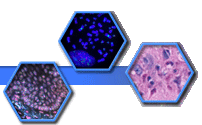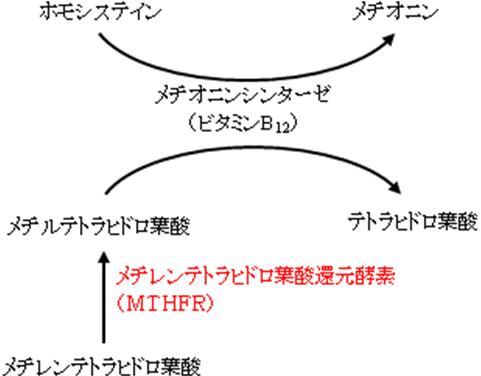
|
 |
MTHFR; METHYLENETETRAHYDROFOLATE REDUCTASE
[別名]
5,10-METHYLENETETRAHYDROFOLATE REDUCTASE
キーワード
葉酸、多型、高ホモシステイン血症、冠動脈疾患、脳梗塞
歴史とあらまし
メチレンテトラヒドロ葉酸還元酵素(MTHFR)は、1994年にGoyetteらによってブタ肝臓からPCR法を用いて90 bpのcDNAとして単離された(Ref. 1)。その後、このブタDNA配列を用いて、ヒトMTHFR遺伝子配列がヒト肝臓cDNAライブラリーからスクリーニングされた。MTHFRは遺伝子地図上の1p36.3に位置する。
分子構造
ヒトにおいてMTHFRは、656個のアミノ酸からなる分子量103-kDaのホモ二量体であり、そのアミノ酸配列はヒトとマウス間でおおよそ90%が一致している(Ref. 2)。また、予測されているアミノ酸配列はヒトからバクテリアに至るまで高度に保存されている。
機能
MTHFR (EC 1.5.1.20)は、メチレンテトラヒドロ葉酸からメチルテトラヒドロ葉酸への変換を触媒する酵素である。その結果、ホモシステインからメチオニンへの変換が促進する。MTHFR遺伝子の塩基番号677C→T transition (rs1801133)は、222番目のアミノ酸をアラニン(Ala)からバリン(Val)に変化させる多型(Ala222Val)である。このC/T多型におけるTT型を有するヒトの血中ホモシステイン濃度は、Cアレルを有するヒトより高い(Ref. 3)。また、この多型は世界中の多くの人種で比較的高頻度に認められる。しかしながら、そのマイナーアリル頻度は白人で0.30、アフリカン系アメリカ人で0.10であるので、人種間で比較的頻度が異なる(Ref. 4)。Nishinoら(Ref. 5)によると、日本人におけるMTHFR遺伝子677C→T多型のマイナーアリル頻度は約0.4と高いことが報告されている。

老化・老年病における意義
高ホモシステイン血症は、動脈硬化性疾患などの危険因子であるとする報告が多い。欧米の研究では、血中ホモシステイン濃度は、脳梗塞(Ref. 6)および冠動脈疾患(Ref. 7)の危険因子となるという報告がある。一方で否定的な報告もある(Ref. 8)。日本人においては脳梗塞患者で血中ホモシステイン濃度が健常者に比較して高値である(Ref. 9)。MTHFR遺伝子677C→T多型を有すると血中ホモシステイン濃度が高値となり、冠動脈疾患および脳梗塞の危険因子となる(Ref. 3)。葉酸摂取によって血中ホモシステイン濃度を下げることが可能なため(Ref. 10)、MTHFR遺伝子677C→T多型を鑑別することにより、適切な栄養指導が可能となり脳梗塞および冠動脈疾患による寝たきり予防などに効果があると考えられる。
Database
参考文献
1) Goyette P, Sumner JS, Milos R, Duncan AM, Rosenblatt DS, Matthews RG,
Rozen R. Human methylenetetrahydrofolate reductase: isolation of cDNA,
mapping and mutation identification. Nat Genet. 7:195-200, 1994 (PMID:
7920641)
2) Goyette P, Pai A, Milos R, Frosst P, Tran P, Chen Z, Chan M,
Rozen R. Gene structure of human and mouse methylenetetrahydrofolate
reductase (MTHFR). Mamm Genome 9:652-6, 1998 (PMID: 9680386)
3) Frosst P,
Blom HJ, Milos R, Goyette P, Sheppard CA, Matthews RG, Boers GJ, den Heijer
M, Kluijtmans LA, van den Heuvel LP, et al. A candidate genetic risk factor
for vascular disease: a common mutation in methylenetetrahydrofolate
reductase. Nat Genet 10:111-113, 1995 (PMID: 7647779)
4) McAndrew PE,
Brandt JT, Pearl DK, Prior TW. The incidence of the gene for thermolabile
methylene tetrahydrofolate reductase in African Americans. Thromb Res.
83:195-198, 1996 (PMID: 8837319)
5) Nishio H, Lee MJ, Fujii M, Kario K,
Kayaba K, Shimada K, Matsuo M, Sumino K. A common mutation in
methylenetetrahydrofolate reductase gene among the Japanese population. Jpn
J Hum Genet 41:247-251, 1996 (PMID: 8771990)
6) Perry IJ, Refsum H,
Morris RW, Ebrahim SB, Ueland PM, Shaper AG. Prospective study of serum
total homocysteine concentration and risk of stroke in middle-aged British
men. Lancet. 346:1395-1398, 1995 (PMID: 7475822)
7) McCully KS. Vascular
pathology of homocysteinemia: implications for the pathogenesis of
arteriosclerosis. Am J Pathol 56:111-128, 1969 (PMID: 5792556)
8) Alfthan
G, Pekkanen J, Jauhiainen M, Pitkaniemi J, Karvonen M, Tuomilehto J, Salonen
JT, Ehnholm C. Relation of serum homocysteine and lipoprotein(a)
concentrations to atherosclerotic disease in a prospective Finnish
population based study. Atherosclerosis. 106:9-19, 1994 (PMID: 8018111)
9) Araki A, Sako Y, Fukushima Y, Matsumoto M, Asada T, Kita T. Plasma
sulfhydryl-containing amino acids in patients with cerebral infarction and
in hypertensive subjects. Atherosclerosis 79:139-146, 1989 (PMID: 2597223)
10) Jacques PF, Selhub J, Bostom AG, Wilson PW, Rosenberg IH. The effect of
folic acid fortification on plasma folate and total homocysteine
concentrations. N Engl J Med 340:1449-1454, 1999 (PMID: 10320382)
作成者
福典之、田中雅嗣 20120307
Update 20120629